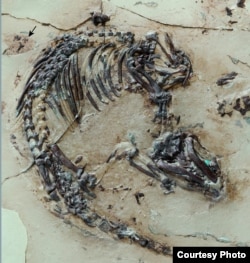A recently discovered fossil of a hedgehog-like creature may push back the date at which scientists believe mammals began to appear on Earth by more than 60 million years.
The 125-million-year-old fossil, which was found in Spain, has what researchers say is the “earliest record of preserved mammalian hair structures and inner organs.”
The creature, which has been named Spinolestes xenarthrosus, is “remarkably intact” complete with guard hairs and hedgehog-like spines.
The fossil also shows an external ear lobe as well as the tissue of internal organs, including the liver and lung.
A team of researchers from the Autonomous University of Madrid, University of Bonn and the University of Chicago said the hair and spines are the “earliest-known examples in mammalian evolutionary history.”
"Spinolestes is a spectacular find. It is stunning to see almost perfectly preserved skin and hair structures fossilized in microscopic detail in such an old fossil," said study co-author Zhe-Xi Luo, professor of organismal biology and anatomy at the University of Chicago, in a statement. "This Cretaceous furball displays the entire structural diversity of modern mammalian skin and hairs."
The fossil was found in an area of central Spain that was a lush wetland 125 million years ago. The site has been pored over by paleontologists for over 30 years, yielding hundreds of fossils.
The fossilized Spinolestes was found in 2011.
Researchers said the animal was about 24 cm in length and weighed between 50 to 70 grams, making it roughly the size of a young rat. Its teeth and skeleton lead scientists to believe Spinolestes was a “ground dweller” that survived on a diet of bugs.
Spinolestes’ hair and skin were similar to modern mammals, researchers said, noting that they saw multiple hairs formed from the same skin pore. It also has tiny spines on its back.
The specimen was so well preserved that scientists were even able to see that it suffered from a fungal skin infection still suffered by modern day mammals.
"Hairs and hair-related integumentary structures are fundamental to the livelihood of mammals, and this fossil shows that an ancestral, long-extinct lineage had grown these structures in exactly the same way that modern mammals do," Luo said. "Spinolestes gives us a spectacular revelation about this central aspect of mammalian biology."
A study about Spinolestes appeared in the journal Nature.










